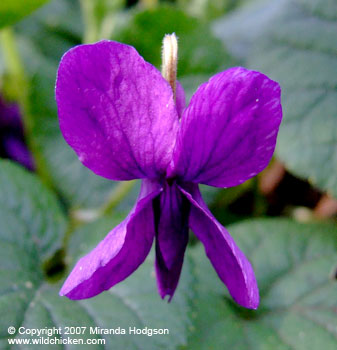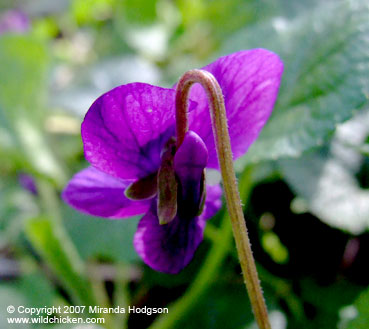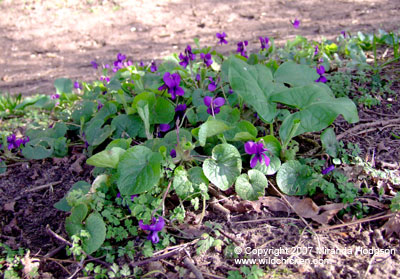




The large leaves to the right of the picture are those of Arum maculatum,
not V. odorata.
Viola odorata (also called sweet violet and English violet)
Viola
odorata
Semi-evergreen, clump forming perennial, grown for sweetly scented purple or white flowers in late winter and early spring. The scent is sweet, but the perfume contains ionine which briefly numbs our sense of smell, so one sniff is all you get at a time. It would be interesting to know how this affects other mammals.
Good for a woodland edge setting in dappled shade, under shrubs or at the front of borders.
Attractive to bees.
Flowers in late winter and early spring.
Habit - forms a rosette of leaves and flowers, growing from a central rhizome. H: up to 10cm. S: up to 15cm.
Stem - those of the leaf are pale green and those of the flower have a pinkish tinge. Both have tiny hairs and form a rough square in cross-section.
Leaves - a rounded heart shape, with lightly lobed edges, in mid-green.
Flowers - up to 2.5cm across, with five petals, the lower one with a rounded spur at the back. Flowers range in colour from purple to white and many have lined markings on the lower petal.
Full sun to dappled shade.
Humus-rich, moist, well-drained.
Hardy.
Dig in plenty of compost when planting out. Dead head to prolong flowering. Removing runners during flowering will also help to give larger flowers. Benefits from an occasional feed with a balanced fertiliser.
May be attacked by slugs and snails, and is also vulnerable to red spider mite in dry conditions. The violet gall midge may also be an issue. Keeping the plants healthy and well fed and watered will improve their resistance to problems.
By fresh seed or division after flowering.
Garden Plant Information list of plant care info by botanical name